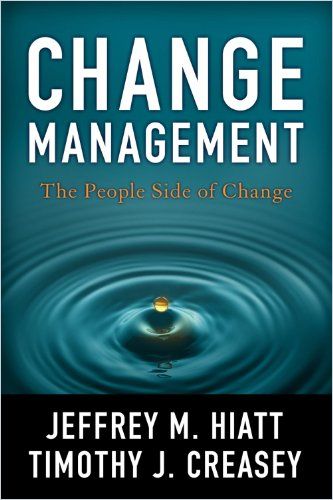In this evolved, worthwhile guide, change management leaders Jeffrey M. Hiatt and Timothy J. Creasey teach how to drive effective change.

Make Change Happen
For most people, “change” is a scary word. It triggers insecurity, uncertainty and anxiety. Founder of the Change Management Learning Center and CEO of Prosci Jeffrey M. Hiatt and Prosci Chief Development Officer Timothy J. Creasey provide a tremendous service by explaining why and how to focus on your most important asset – your employees – when instituting organizational change. Upper-level executives often err by suddenly announcing plans for an operational shift and expecting everyone in the company to embrace the news. To gain the cooperation of your workforce, follow the authors’ advice for managing a change initiative carefully and cooperatively.
Only a Theory
The best technology, state-of-the-art processing and evolving job descriptions are worthless if your people don’t welcome and utilize them. Managing change, the authors insist, rests on enabling your employees to accept and execute new methods of achieving your business objectives.
A fundamental assumption of change is that something different is possible.Jeffrey Hiatt and Timothy Creasey
Your employees must know the reasons for a change initiative, and you must achieve 100% buy-in from those whom change affects. To get that level of cooperation, help your people envision a positive outcome achieved through collective effort.
Customize
The authors warn that every change and every situation is different. Effective change leaders customize their approach to meet their organization’s needs.
Never assume your employees share management’s excitement about change. New procedures, programs and tactics disrupt employees’ routines and could change their careers. Leaders must commit to supporting employees for the duration of the change and to dealing with negativity or resistance in a collaborative manner. Edicts from above only impede change.
Some employees may have heard more than what was said, and their translation of that message will be unique to their personal situations.Jeffrey Hiatt and Timothy Creasey
Change management is most effective when an influential leader takes charge or sponsors the process. This executive sponsor must be active and visible, uniting pivotal unit leaders in support of the cause, speaking directly and often with employees, and motivating departmental managers to act as sponsors of the change and to work with reluctant or recalcitrant employees.
Compliance
Today, employees challenge authority and claim ownership of their contributions to the company. They obey reluctantly, and leaders must persuade them. From their perspective, change threatens stability and comfort. Employees who fear an unknown future don’t care if their leaders have a great plan. They want to know the reasons for the change, whether senior management is fully on board, what current problems the change should fix and why it has to happen now.
Change management adds structure and intent for moving employees from their current state to their future state.Jeffrey Hiatt and Timothy Creasey
Hiatt and Creasey explain that the Prosci ADKAR change management model starts with employee awareness, builds employees’ desire to foment change, helps employees understand what they must do, enables employee competency in applying new tools and procedures, and reinforces the change with recognition and remuneration.
Successful Transitions
To be successful, change must happen on the individual and organizational levels. Employees will complain if you tinker with a system that works. Share your reasoning – tell them, for example, that your vendor no longer supports your old software and that your customers’ needs are expanding. Make the reasons for change clear.
Change management activities must be tailored according to where you are in the change, and be ongoing through the transition phase.Jeffrey Hiatt and Timothy Creasey
Optimal change management involves preparing for the change before you launch a change effort. During the pre-launch period, make sure your change management team has the required resources and identify your sponsors.
As you formulate and execute your change plans, empower every affected employee to achieve specific change objectives. Provide coaching so supervisors and managers can assist their people throughout the transition. After you activate change mechanisms, evaluate the results. Recognize and celebrate employees’ accomplishments.
To prepare for your next change, step back and evaluate the entire project. Ask what went well and what didn’t.
A Seismic Shift
Organizations must stay nimble, because change has become the norm, not the exception. Companies that successfully apply change management principles may notice a shift in employees’ collective attitudes and individual behavior.
Your organization has achieved change competency when your managers and employees carry out the same behaviors and activities that made a previous change successful. Change-competent organizations experience a psychological transition. Employees know change is part of their jobs, understand that it’s inevitable and swing into action when necessary.
Although [they’re] a main focus of organizational change management, employees are often neglected when it comes to building competency in change.Jeffrey Hiatt and Timothy Creasey
Hiatt and Creasey assume the perspective of each participant in a change-management initiative and identify their individual goals. Executives should watch for market shifts that offer new growth and financial opportunities. Project teams should supply managers, sponsors and employees with the methods and tools for change. Throughout the change, managers should provide dependable support for employees. Frontline workers should exhibit their proficiency under current conditions, throughout the change transition and in the new environment.
If employees ask what happens if you don’t change, tell them job losses, fewer advancement opportunities and loss of revenue. Hiatt and Creasey urge you to remind workers who oppose the change that they can complain and stay in denial, and suffer. Or they can gather information, stay positive, express curiosity and maximize this professional growth opportunity.
How It’s Done
This direct, practical, no-nonsense guide is an indispensable manual covering the practical aspects of organizing for change and the equally crucial psychological aspects of managing employee resistance, which Hiatt and Creasey depict as a certainty. Inexperienced change managers will welcome their emphasis on coping with uncertainty and will rely on their specific tactics for doing so.
To lead change at an organizational level, you must be able to lead change at an individual level.Jeffrey Hiatt and Timothy Creasey
The author’s accessible structure means you can read a chapter for specific instructions or digest the work as a whole to guide your transition.
Jeffrey M. Hiatt also wrote ADKAR and Employee’s Survival Guide to Change. Other solid books on change management include Managing Transitions by William Bridges and Susan Bridges; Our Iceberg Is Melting by John P. Kotter; and Who Moved My Cheese? by Spencer Johnson, MD.














